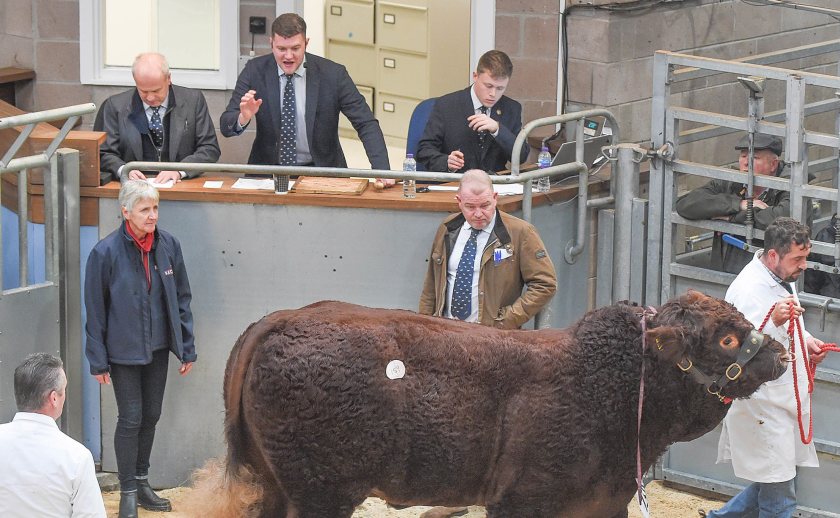
Strong trade through Scotland’s livestock marts is continuing to bolster confidence in the beef sector, despite prices easing slightly from their early summer peak.
According to auctioneer Andrew Hunter-Blair of Craig Wilson Ltd in Dumfries and Galloway, current store cattle values remain significantly higher year-on-year – a clear sign that optimism is holding firm among beef producers.
“Prices hit a peak in June, with store cattle being sold for £400-600 more on the year and heifers with calves at foot averaging up to £1000 more,” said Mr Hunter-Blair.
“We’d anticipated the price would drop over the summer, which it has, but it’s still higher than it was last year and from sales last week it looks like prices are starting to pick up again.
“This could partly be due to low numbers as a result of a lot of forward selling in the Spring. It's a new age of pricing and we need to get used to it.
"Demand is strong and it’s really good to see producers rewarded for the work they put in with prices where they should be. There’s definitely positivity among our customers.”
Mr Hunter-Blair also noted a noticeable increase in activity through the sale ring, with more buyers and sellers participating compared to previous years.
“There have definitely been more folk around the ring and trading. They are seeing the value. There also seem to be fewer private sales on farm.
"In the mart, there’s the competition that you don’t get with a private sale, with say 6-8 buyers bidding, which widens the market potential and you get the best price on the day. Many wouldn’t dream of asking those prices at home.”
Murray Steel, auctioneer at United Auctions and representative for young auctioneers at the Institute of Auctioneers and Appraisers in Scotland (IAAS), echoed the upbeat tone.
“There’s a lack of numbers in the suckler herd both domestically and globally. It’s an older industry and many have come out of beef as they weren’t getting the returns,” said Mr Steel.
“We’re seeing now the impact of the low supply and rising demand. While fat cattle prices are back at the abattoirs, they are going from strength to strength in the ring.
"Those who have stuck at beef are now reaping the rewards. Everyone is upbeat and in good spirits.”
In recent years, the sector has experienced several herd dispersals, but Mr Steel believes those still in production are determined to keep numbers up.
“Those who are staying in cows are keeping their numbers up and buying more which will help stabilise the national herd. The current values will hopefully encourage them to continue to invest.”
Looking ahead, he anticipates a sharper trade towards the end of the year: “The value of the marts really shows at times like this," Mr Steel expalined.
"The ring’s been paramount in the way trade has risen, and the marts are a pivotal part in getting store and fat to where it is today.
"The processors may see tight trade in the Spring which will trickle down but there’s definitely a bright future for breeders and sellers at the marts. There’s never been a better time, the trade is going from strength to strength.”
Neil Wilson, executive director of the Institute of Appraisers and Auctioneers in Scotland (IAAS), praised the role of marts in supporting the sector through challenging times.
“The marts are agile and remain dynamic and active to meet market demand. Despite the challenges of US trade deals, policy changes, economic uncertainties, and more recently, BTV, it’s excellent to see the beef trade as strong as ever.
"The marts have a significant role in safeguarding a competitive marketplace, and never is it more obvious than when balancing supply and demand.”
UK beef production is projected to fall by 5% in 2025, but the AHDB forecasts a 1% rise in consumer demand next year.
To help future-proof the sector, IAAS is working with the Red Meat Resilience Group and Quality Meat Scotland through the Meating Your Potential campaign – promoting the sustainability and viability of Scottish red meat production.
“We need to work together along the whole supply chain to reverse the decline of suckler cow numbers and get the best returns back to the farmgate,” added Mr Wilson.
“Scottish beef is the backbone of Scottish agriculture, and we hope this rise in values will encourage producers to reinvest.
"Whether it’s putting on two or 22 more cows, it will all contribute towards stabilising the herd and ensuring the future of beef production in Scotland.”
